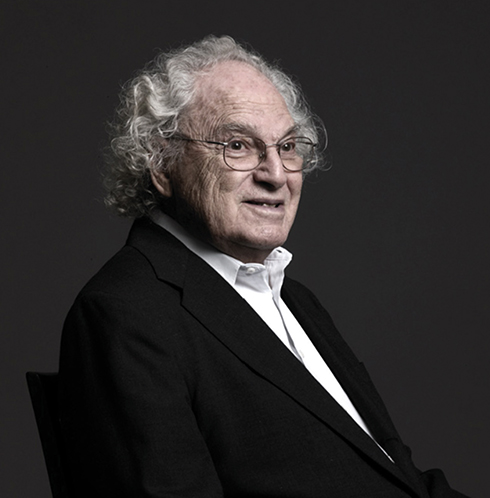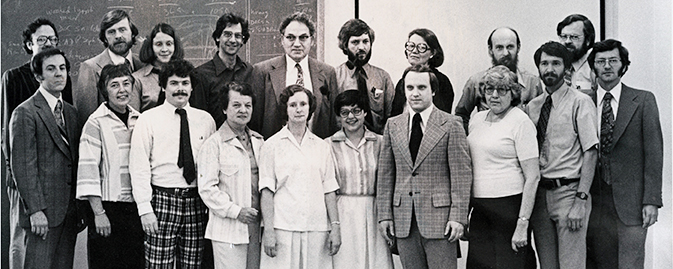- History Home
- People, Leadership & Service
- A Legacy of Excellence
- History & Impact
- Meetings Through the Years
- Resources
Obituary - Herbert A. Hauptman (1917-2011)Biography | Publications | Curriculum Vitae | Videos | Slides | Articles | Obituary
Herb was born in New York City, the oldest of three sons of Israel Hauptman - a printer - and Leah (Rosenfeld) Hauptman who was a sales clerk in the ladies' hat department of a prominent New York City department store. In later years, he fondly recalled the passionate interest and the innate understanding and appreciation of science and mathematics that arose in him at a very early age. He described how he often entertained himself as a youth by playing with mathematical calculations related to things in his home environment. He attended Townsend Harris High School, where his interest in science and mathematics was nurtured, and then went on to the City College of New York where he graduated in 1937. He also earned a master's degree in mathematics at Columbia University in 1939. On a blind double date in the fall of 1940, Herb found that he preferred his friend's date. Displaying the same drive that later led to his professional success, he quickly acted on his emotions and, within a matter of weeks, married his young bride, Edith Citrynell, an educator. Shortly after he and Edith were married, he joined the legions of young American men who were sent to serve in World War II. A Navy ensign, he was stationed in the Southwest Pacific where he was trained as a weather forecaster. He was made a permanent "officer of the day" and was responsible for responding to a variety of crises. While he only had one day of firefighter training, he also served as a Fire Marshall in the Philippines - an assignment that twice nearly cost him his life. His time in the war was marred with close calls and the constant presence of death and destruction. During his war years, he spent his rare moments of spare time studying calculus (he brought the book with him to the South Pacific) and solving mathematical problems. His wartime experience was a constant memory throughout his life and led him, in future years, to protest actively against American involvement in other military actions, including the Vietnam War. In 1947, he began working at the Naval Research Laboratory (NRL) in Washington, D.C. where he remained until 1970. During his career there, he also earned his PhD in mathematics from the University of Maryland in 1955. During his time at NRL, he became fascinated with the problem of how to directly determine molecular structures through the methodology of x-ray crystallography, a problem that had daunted other scientists for decades. Along with Jerome Karle, he co-published a solution in 1953 in a book entitled, Solution of the Phase Problem I: The Centrosymmetric Crystal. However, for many years other scientists were skeptical of the work and it was largely ignored. It was finally accepted in the 1970's and received the recognition it deserved with the award, in 1985, of a Nobel Prize that he shared with Jerome.
Back row, l to r: Chuck Weeks, Bill Duax, Mary Frankowiak, Ed Green, Herb Hauptman, Bob Blessing, Jane Griffin, Doug Dorset, Walt Pangborn
Front Row, l to r: Doug Rohrer, Phyillis Strong, George DeTitta, Elaine DeJarnette, Mary Erman, Vivian Cody, Steven Potter,Catherine DeVine, Dave Smith, David Langs.
In 1970, he joined the crystallographic group of a small, non-profit biomedical research institute, the Medical Foundation of Buffalo (MFB). In 1972, he became MFB's Research Director and later, its President. In 1994, MFB was renamed the Hauptman-Woodward Medical Research Institute (HWI) to honor him as well as Helen Woodward-Rivas, the philanthropist who provided the seed funds for the institute. Herb also served as Professor in the Department of Structural Biology, the Department of Biophysical Sciences and as Distinguished Professor in the Department of Computer Science at the University at Buffalo. In the 1990's and early 2000's, he collaborated with his Buffalo colleagues to develop improvements to his methods that permitted successful application to much larger molecules. A member of the ACA and the US National Academy of Sciences, he received many honorary degrees from colleges and universities in countries as far away as Poland, Israel and Italy. He received an honorary degree from the State University of New York at the 2009 commencement of the University at Buffalo. He received numerous other awards including the Niagara Lutheran Humanitarian award for 2009. Most recently he was named to the inaugural class of ACA Fellows. Herb continued to work on his own new research projects in addition to serving as a mentor and teacher to younger scientists and staff members. He came to work at HWI every day until he was well into his nineties. As a hobby, he enjoyed making stained-glass artwork inspired by mathematically defined, complex geometrical shapes. A permanent collection of these beautiful creations resides at HWI. In addition to his wife, Edith, he is survived by their daughters Barbara Hauptman and Carol Fullerton, PhD, his brother Robert, and many nieces and nephews. He was predeceased by his brother Manuel in 2009.
(Reprinted from RefleXions, Winter 2011, pp18-19) |

 Herb Hauptman died on October 23, 2011 at the age of 94. He was a co-winner of the Nobel Prize in Chemistry in 1985 for developing mathematical methods for deducing the molecular structures of chemical compounds.
Herb Hauptman died on October 23, 2011 at the age of 94. He was a co-winner of the Nobel Prize in Chemistry in 1985 for developing mathematical methods for deducing the molecular structures of chemical compounds.